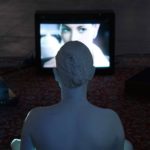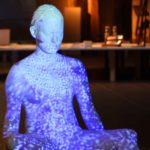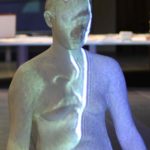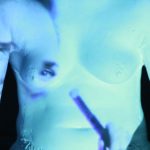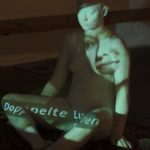Wir sind TV
A human-sized female nude, made of gypsum, sits on a carpet in front of a TV, in which an eight-minute video clip is shown in an endless loop, which is simultaneously projected onto the figure’s body. On the one hand, the body determines the image section, on the other hand, its sinuous surface distorts the movie images, whereby a communication between image and figure occurs. For example, the word “lust” from the subtitle “experience double pleasure” of an advertising spot appears on the inner thighs of the figure.
The video clip imitates the TV program with its movies and commercial breaks and is accompanied by a woman browsing through the programs and lingering on certain film clips. It is a collage of several movies and commercials, in which each individual scene is reduced to a key statement regarding role patterns, e.g. by combining certain scenes with subtitles from different scenes of the same movie, in a way that due to the irritation of the altered movie scene the focus is directed to the statement.
The significance of television goes beyond the aspect of pure entertainment and documentary information. In movies and commercials not only role patterns can be recognized, they also offer a vast number of role templates to the viewer. Their adoption marks the overwriting of one’s own ego, leading identity to a commitment to the surface. Accordingly, this can neither provide information about the nature of a person, nor be described as static. Identity thus becomes a dynamic process of performativity.
